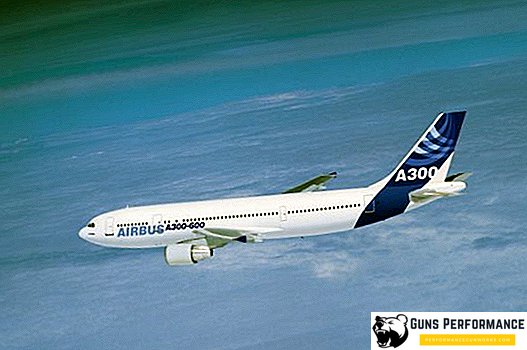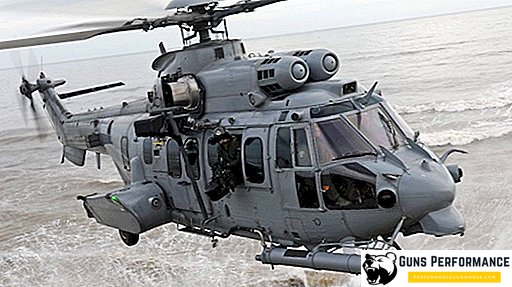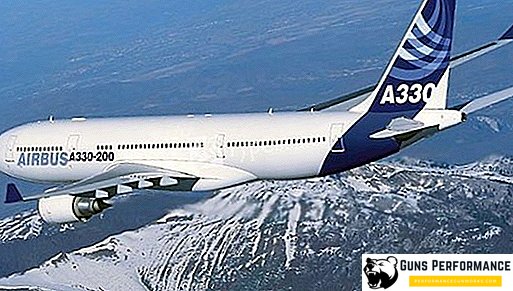The Airbus A300 is the first aircraft of the Airbus concern. Commercial operation of the aircraft began in 1974 and continues to this day.

Aircraft cabin and a review of the layout of the best places
The Airbus A300 (depending on the modification) can have from 266 passenger seats with a two-class layout to 361 - with one-class. It is the two-class layout of the passenger cabin of the aircraft is more common, and, consequently, it should dwell on it in more detail.
Business class Airbus A300 is located in front of the passenger compartment and usually takes 6 rows of seats (as shown in the diagram of the passenger compartment). The business class cabin has two passes, and its seats are arranged according to the “2-2-2” scheme. The seats here are softer and able to fold out enough for a quiet and comfortable rest during the flight. Also, the business class boasts a menu with a wide choice of dishes, as well as less noise, associated mainly with some distance from the noisier economy class.

However, although the business class seats are the best in the entire ship, but among them there are a number of not very successful options. So, the seats located in the first row, although they do not have a seat in front of them, which provides additional space for the feet of passengers, but, nevertheless, they are located in close proximity to the toilets and utility rooms for service personnel. This feature can seriously interfere with a peaceful rest, especially at night: after all, the light here will be lit constantly, and the frequent movement and sound of opening-closing doors will prevent people who are sensitive to noise from falling asleep. Also not very successful for the business class in the Airbus A300 aircraft are the seats located in the fifth and sixth rows. This is due to their some distance from the general business class cabin and the fact that they are located directly at the partition connecting the business class with a noisy economy class.
The economy class is located immediately behind the business class cabin and covers the rows from 11 to 37. Due to the wide-body plane, there are also two aisles, and the seats are arranged according to the 2-4-2 scheme (except for the first and 4 last rows). Economy class places are comfortable and very comfortable for rest, and the distance between them allows you to stretch your legs, even for tall people.
The best for economy class aircraft Airbus A300 are places located in the 11th row. Their convenience lies in the fact that they have in front of them only a dividing partition, and, therefore, more legroom. It is also very beneficial lack of seats in the front - no one will tilt the back, thereby limiting the space for the legs. It is also worth remembering that the dressing of food starts from the front seats, and passengers of the 6th row will have a greater choice of dishes and drinks. However, there are special structures for accommodating children, and this in turn means that passengers with children will most likely be here. This fact can seriously affect the quality of rest and all the impressions about the flight in general, especially for people who do not tolerate children's cries and fuss.
Also very convenient are the places located in the 12th row and marked with the letters D, E, F and G (according to the diagram). This is due to the fact that the seats in front of them are slightly pushed forward, thus providing extra legroom. For the same reason, A, C, K and H, located in the 24th row, will be a good choice for an economy class. However, their proximity to the toilet can cause certain inconveniences.

Not the best choice for booking tickets are economy class places located in the 23rd row, as well as 24 row seats marked with the letters D, E, F and G. The reason is the same: close proximity to the toilet facilities. And, finally, the least convenient for the Airbus A300 are places located in rows numbered 36 and 37. Their inconvenience is also due to the location close to the toilets. Constant queues, the sound of opening-closing doors, and, in some cases, an unpleasant smell can make a flight for passengers staying here a real test of endurance. To this should also be added the fact that the distribution of food for passengers of these places, as a rule, happens last, and, therefore, you can forget about the choice of dishes and drinks. Another important feature for the last 37 rows is that the view through the windows is seriously limited (the row only takes places in the middle between two passes), so in no case should people with weak vestibular apparatus choose these places.
History of creation
The development of the first Airbus aircraft was completed by 1969. Then began the assembly of the first prototype of the Airbus, which received the name A300B1. Three years later, in October 1972, the plane made its first flight. At the same time, another model of the liner was also assembled - the Airbus A300B2, extended by almost 3 meters, the first flight of which was carried out in 1973.
In the spring of 1974, the Airbus A300 was certified, and from that time its commercial operation began. However, Airbus, which had high hopes for the aircraft, went even further: in December of the same year, the A300B4 made the aircraft, which had an increased flight range and improved aerodynamic characteristics.
In the second half of the 1970s and the beginning of the 1980s, attempts were made to develop, on the basis of the A300B4 modification, the Airbus A300C4 cargo-passenger aircraft and the Airbus A300F4 cargo aircraft. However, contrary to expectations, these models are not widely used.

In the early 1980s, Airbus began developing modifications to the A300-600, which had increased passenger capacity and increased flight range. In 1985 began its commercial use. In the same year, the development of the A300-600 variant with an increased flight range, called the A300-600R, began. Operation of the aircraft began in 1989.
In turn, in the beginning of the 90s, already on the basis of the A300-600R, the company SATIC began the development of the Airbus A300-600ST transport aircraft, which received the symbol Beluga. Commercial use of the model was started in 1995.
In 2007, the Airbus A300 series production was completed, thus having lasted 35 years. Only in 2018, the A300 was almost universally decommissioned in global airlines, and its replacement with the more modern Airbus A330 began.
Modifications Airbus A300
There are 5 most notable modifications of the Airbus A300.
- The Airbus A300 is the first modification of the Airbus, the mass production of which was started in 1972. In the early 1970s, it was a truly "revolutionary" model of the aircraft, since it was the first wide-body passenger aircraft equipped with two turbofan engines.
- Airbus A300B4 - A300 modification with increased passenger capacity and flight range. Mass production was started in 1974.
- Airbus A300-600 - a further modification of the Airbus A300, aimed at increasing the maximum possible number of passengers and the long range. Serial production of the liner was started in 1984.
- Airbus A300-600R - Modification of the aircraft A300-600, with an even greater flight range and passenger capacity. Characterized by additional placement in the tail of the additional fuel tank. Serial production began in 1987.
- The Airbus A300-600ST is a modification of the A300-600, a wide-body cargo aircraft, which for its non-standard form was named Beluga ("Beluga"). Used for the transport of large goods (for example, used to transport components for the assembly of the Airbus A310 in Toulouse). Due to the large cargo compartment of the A300-600ST, the Beluga can carry large-sized loads with a total weight of up to 47 tons. Serial production "Beluga" was launched in 1994.

A300 Overview and Features
Aerodynamically, the Airbus A300 is a low-wing swept wing. Plumage - single-chin. The power plant of the liner is presented with two turbofan engines manufactured by General Electric or Pratt & Whitney (depending on the modification).
Specifications A300:
| Airbus A300B2 / B4 | Airbus A300-600R | Airbus A300-600ST | |
| Length m | 53,6 | 54,1 | 56,2 |
| Fuselage width, m | 5,6 | 5,6 | 4 |
| 7.1 - cargo bay | |||
| Interior width, m | 5,4 | 5,4 | - |
| Wingspan, m | 44,8 | 44,8 | 44,8 |
| Area of bearing surfaces, m² | 260 | 260 | 122,4 |
| Height, m | 16,5 | 16,6 | 17,2 |
| Engines | 2 TRD 227 kN - 236 kN | 2 TRD 246 kN - 273.6 kN | General electric |
| Pratt & Whitney JT9D-9 | Pratt & Whitney JT9D-7R4H1, PW 4156, General Electric CF6-80-C2A1 or CF6-80-C2A5 | CF6-80C2A8 | |
| General Electric CF6-80-C2A5 | |||
| Maximum speed, km / h | 910 | 890 | |
| Cruising speed, km / h | 850 | 875 | 750 |
| Range | 3400/5300 km with 270 passengers | 7,000 km with 270 passengers and PW4156 engines | 2779 (load 40 tons), |
| 4632 (cargo 26 tons) | |||
| Number of seats (one class) | 345 | 361 | - |
| Empty weight, kg | A300B2 - 79600, A300B4 - 88500 | 78200 with engines PW4156 | 86000 |
| Max. take-off weight, kg | A300B2 - 142000, A300B4 −165000 | 165,000 with PW4156 engines | 155000 |
Conclusion
The Airbus A300 is the first aircraft of the Airbus concern. His appearance was at the height of air travel in Europe and America, and the new design solution (wide-body aircraft with only two engines) brought him certain popularity among world airlines. A large number of modifications shows that the Airbus had a great potential for improvements, which predetermined its "longevity" in mass production (35 years).












